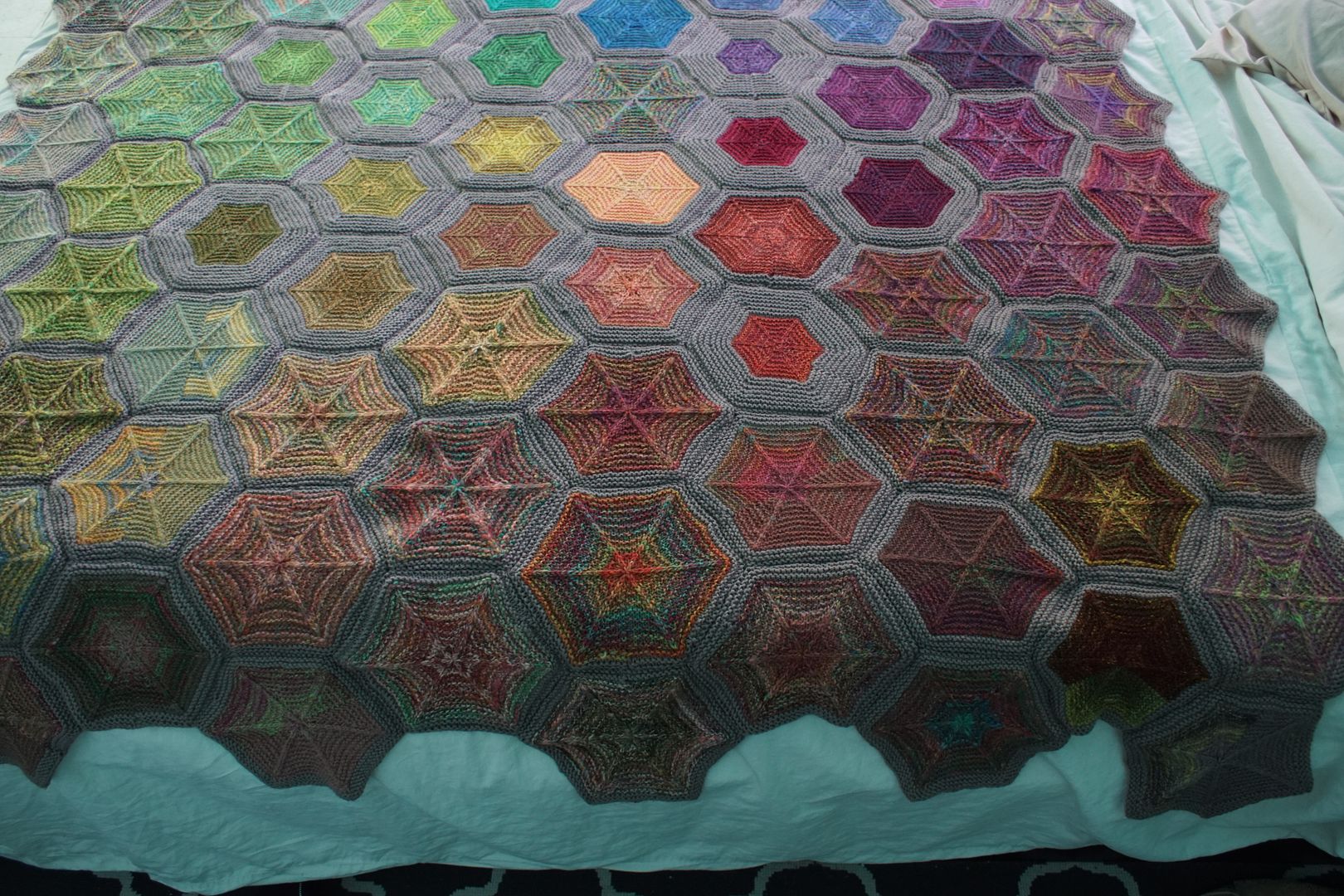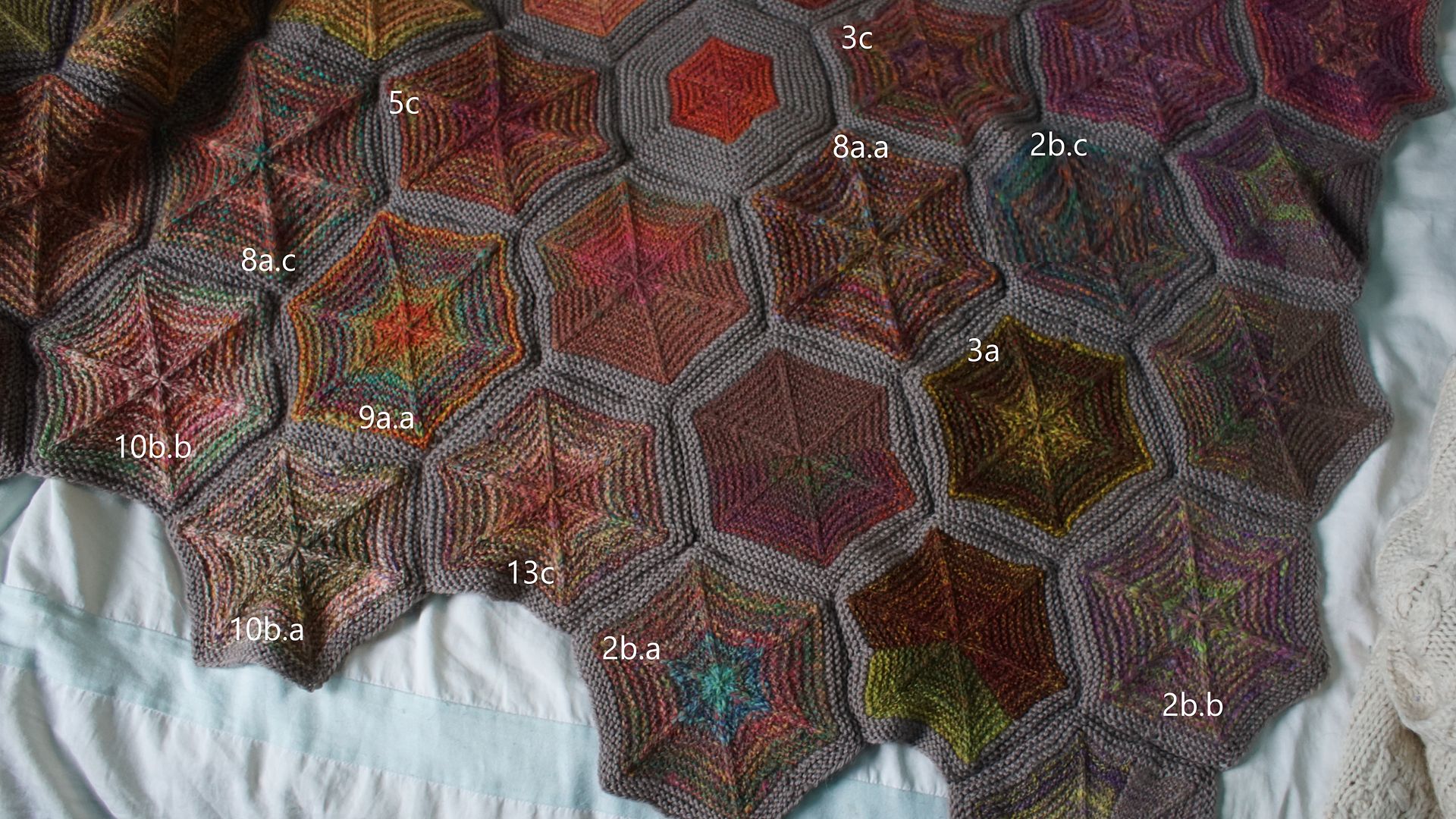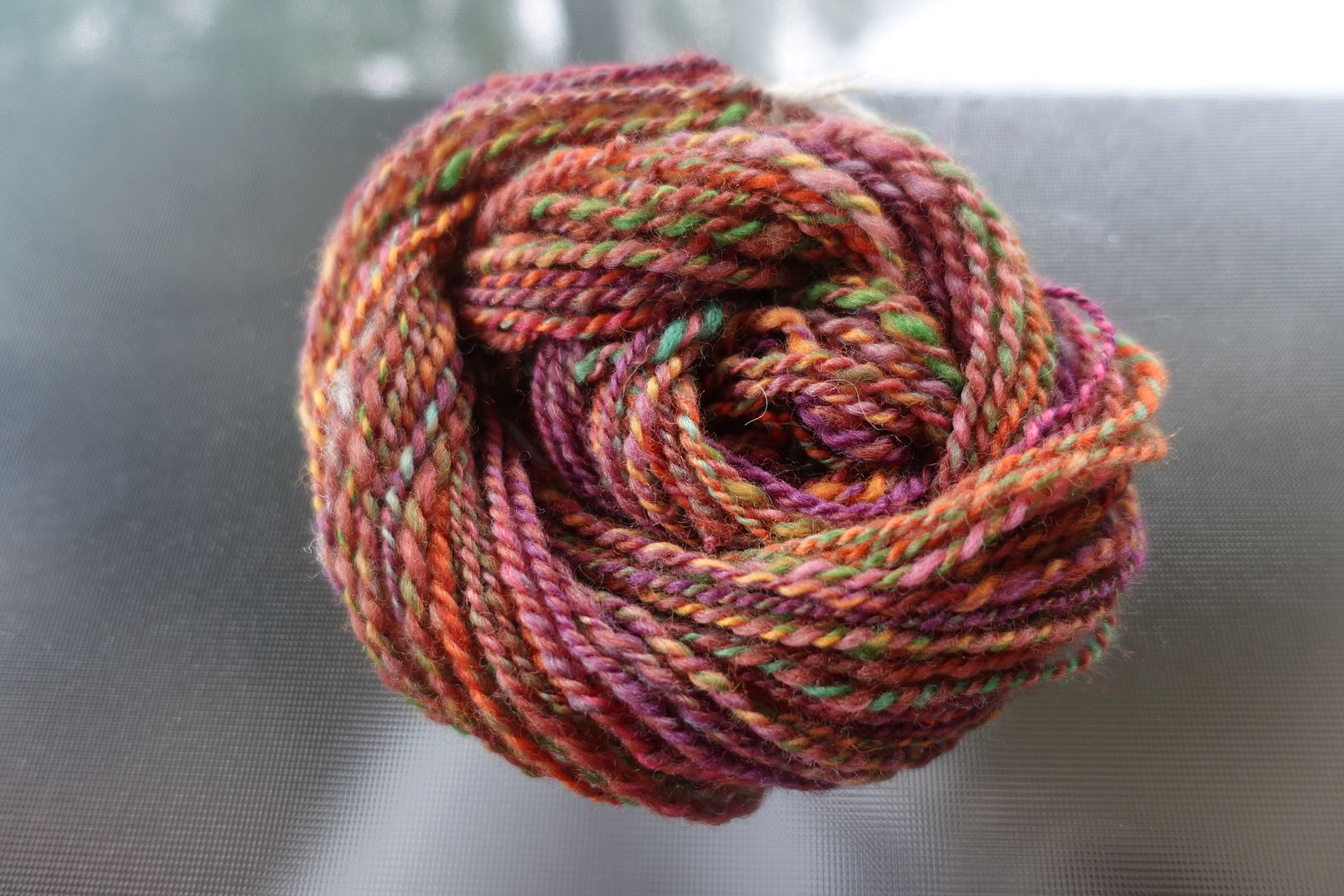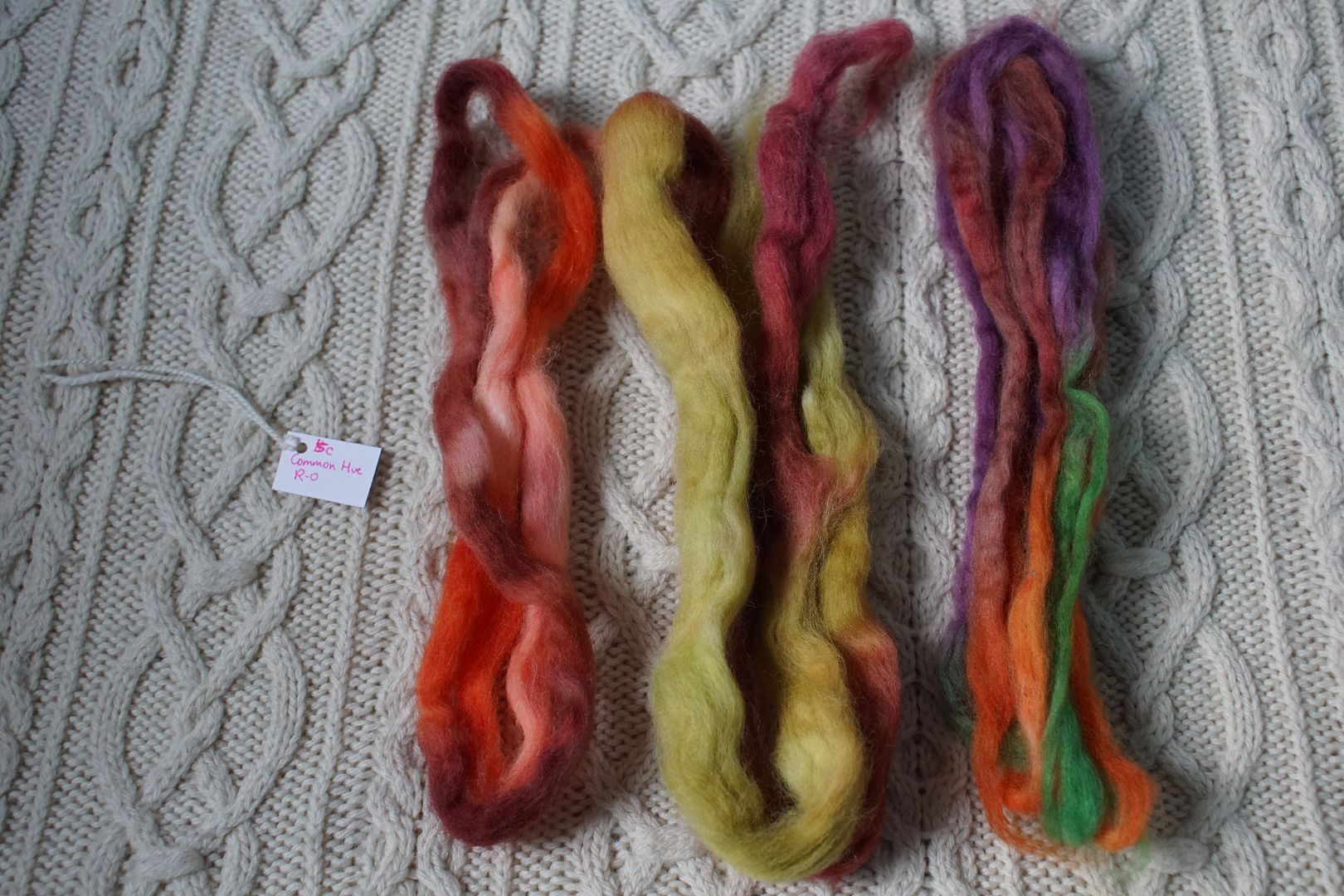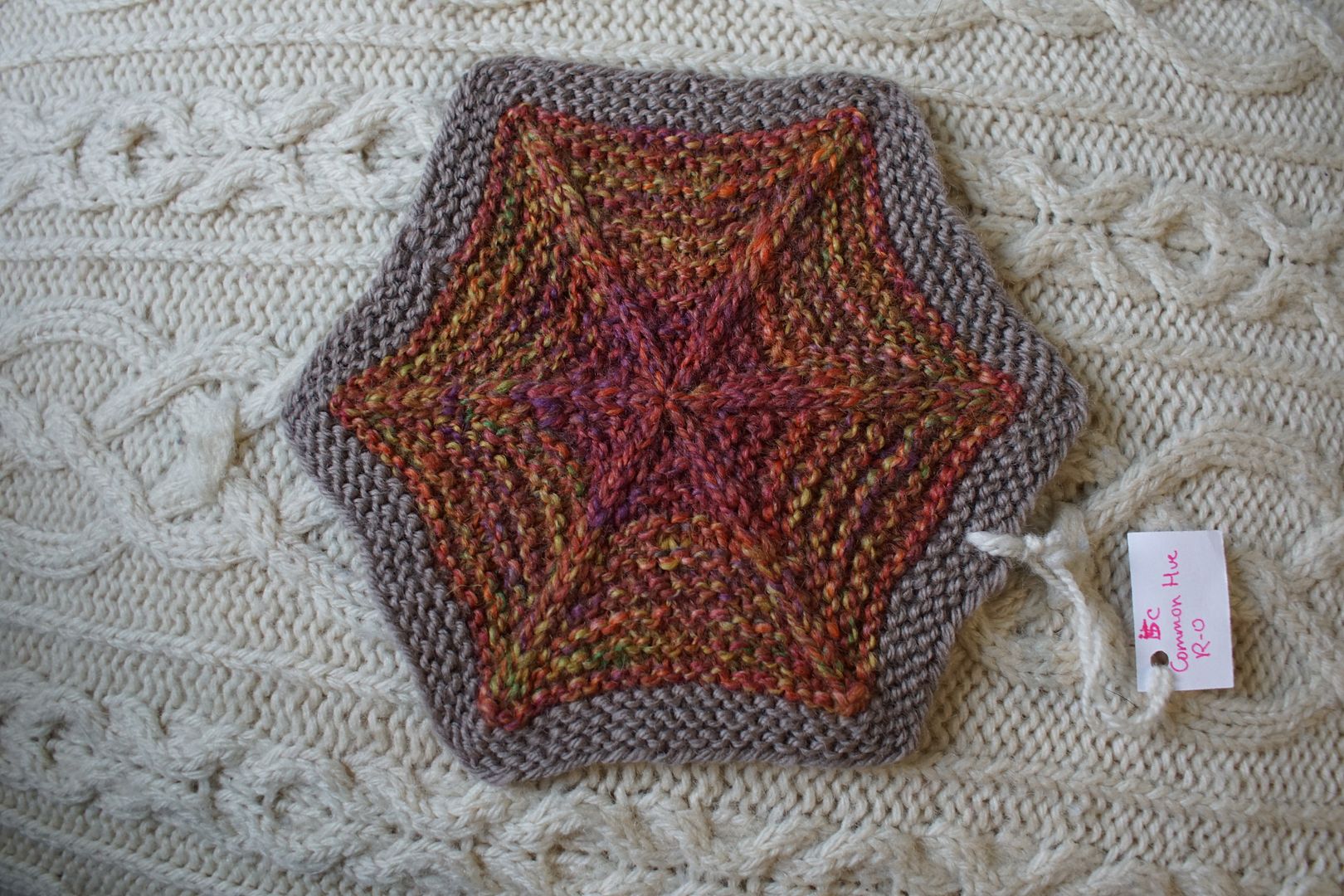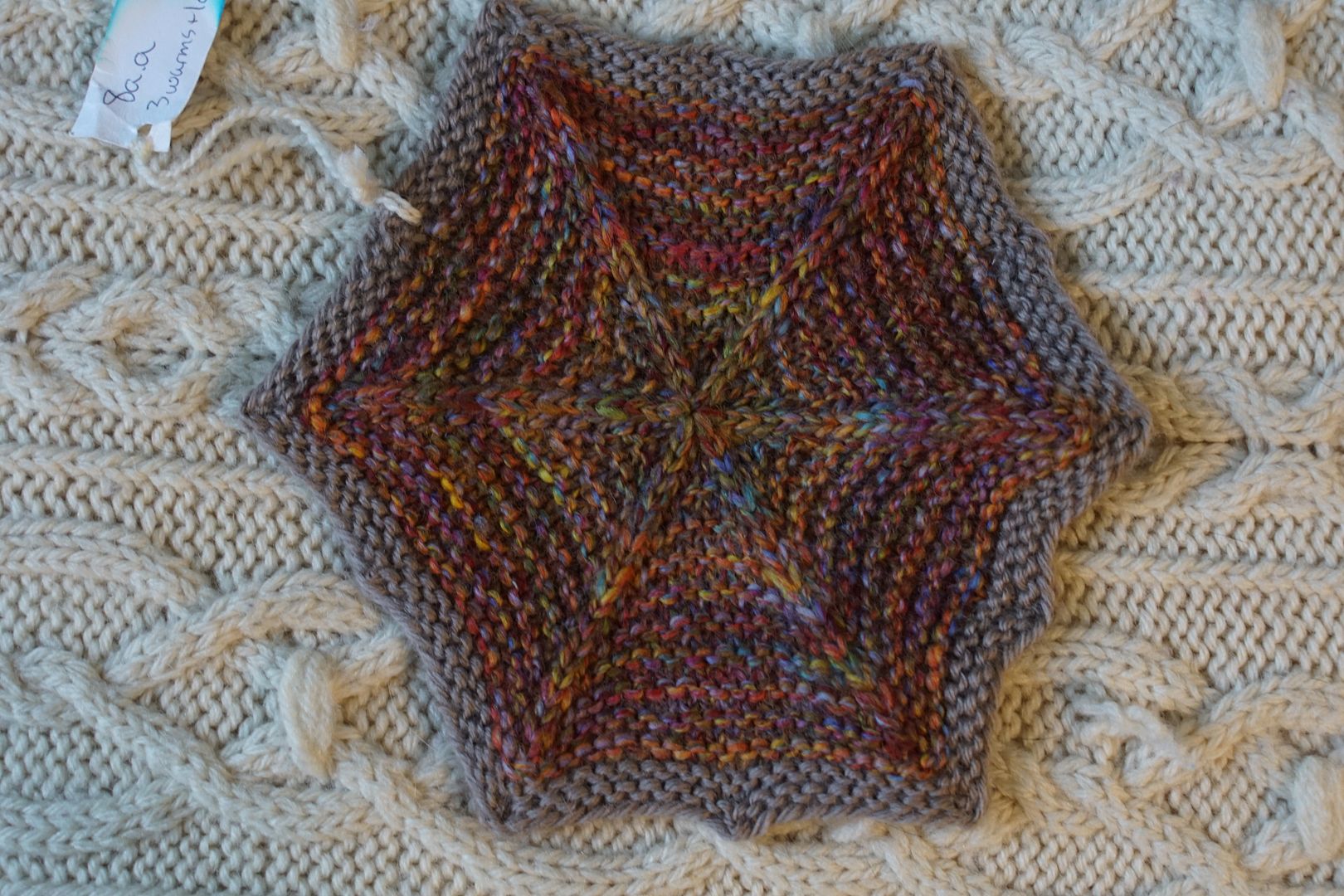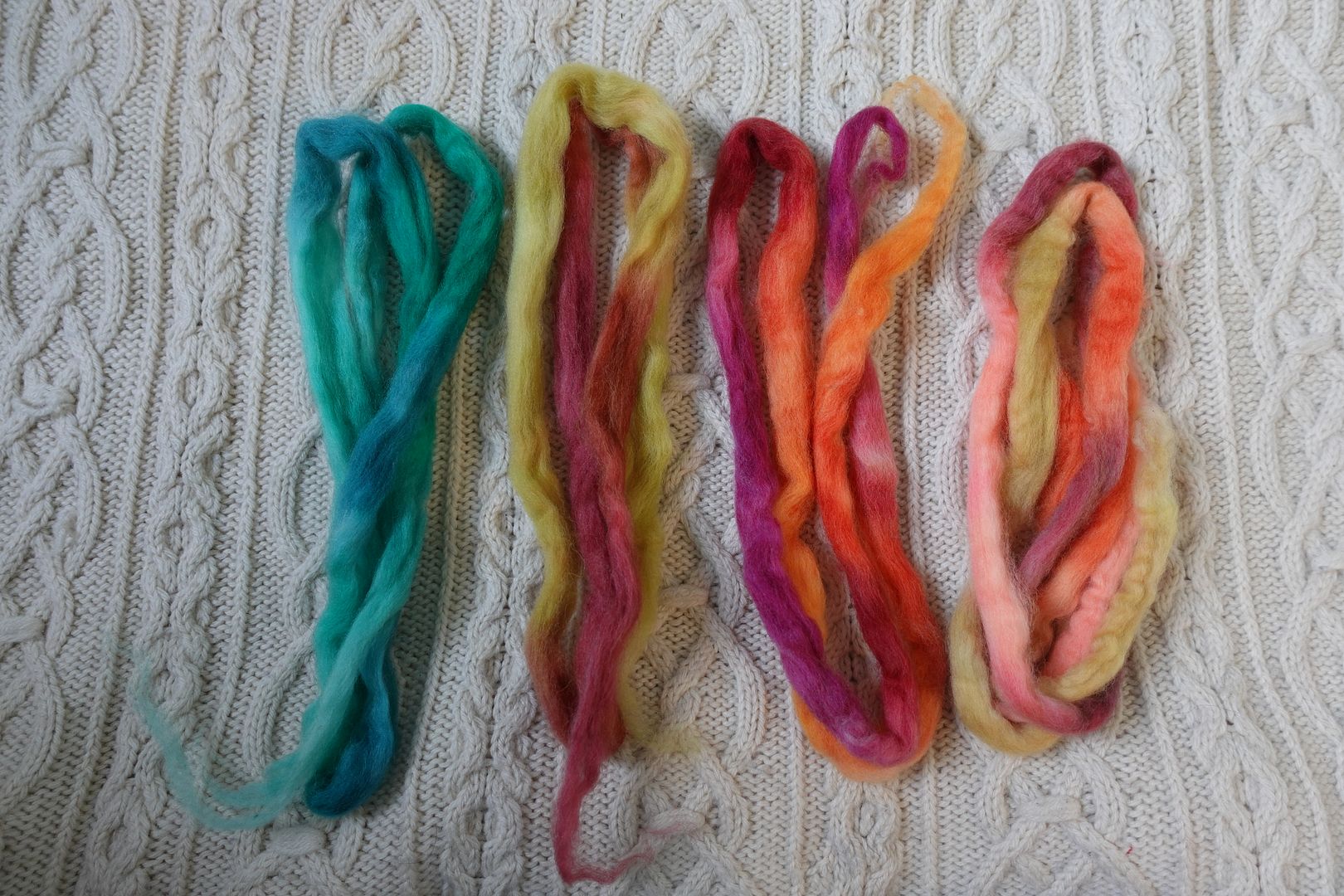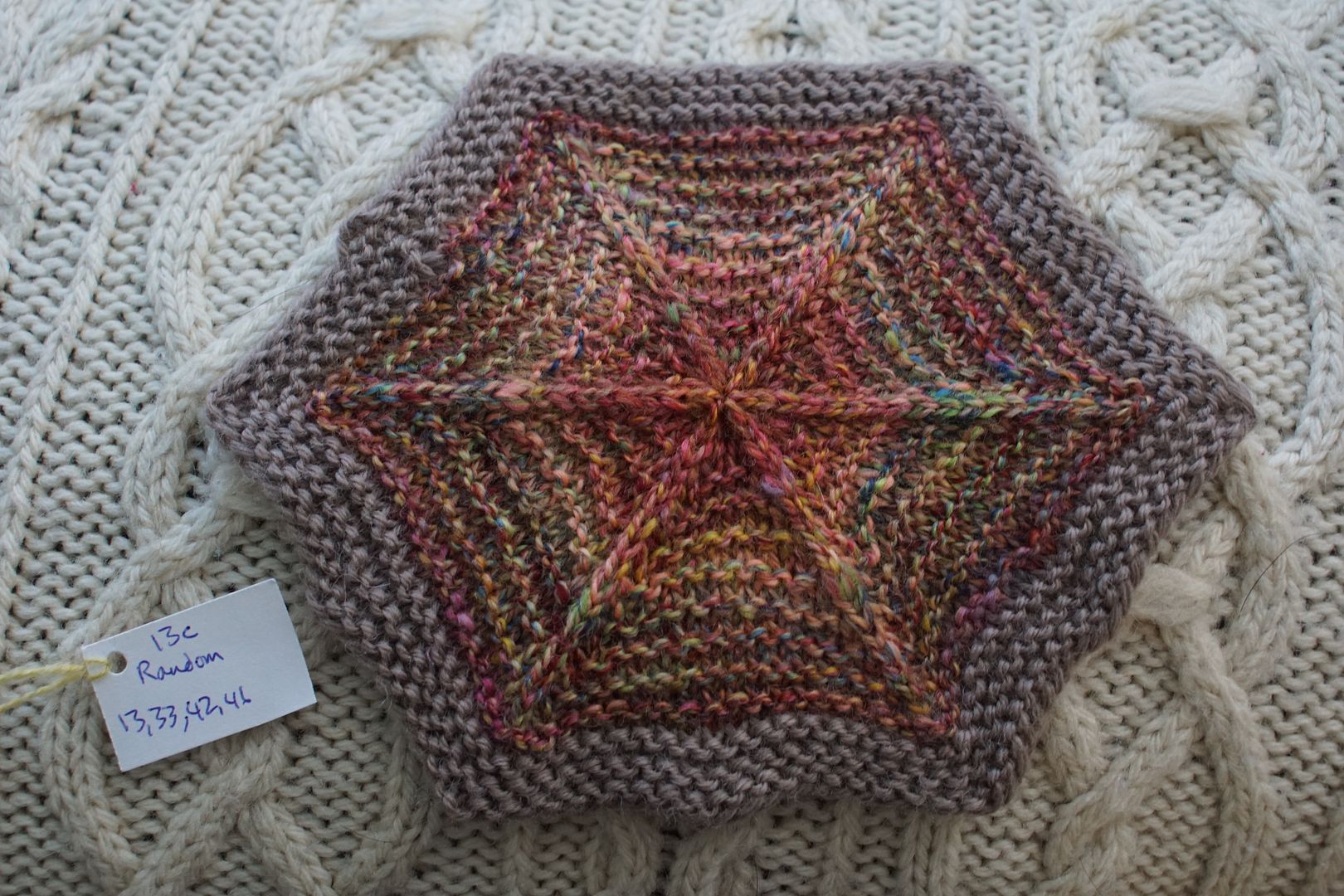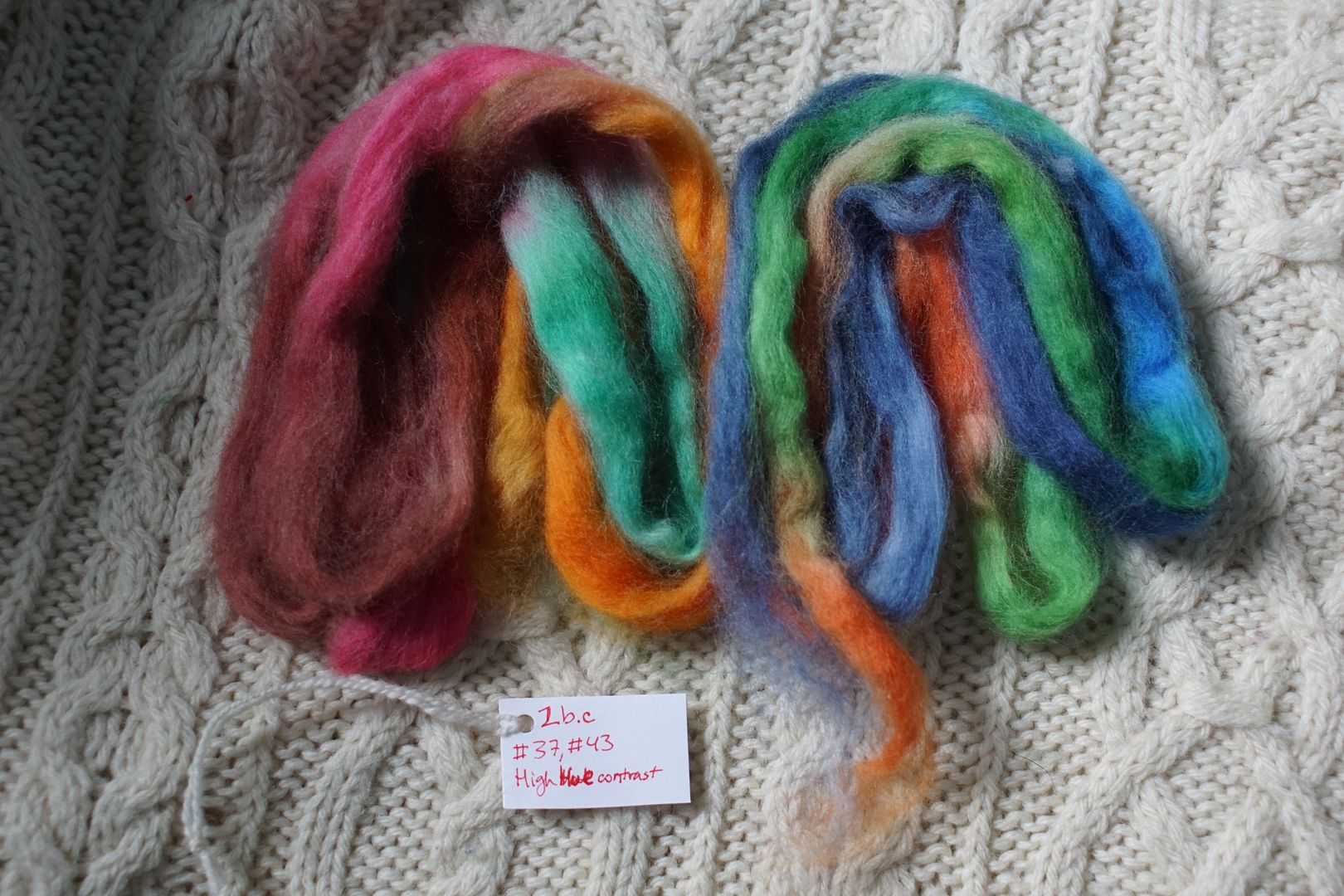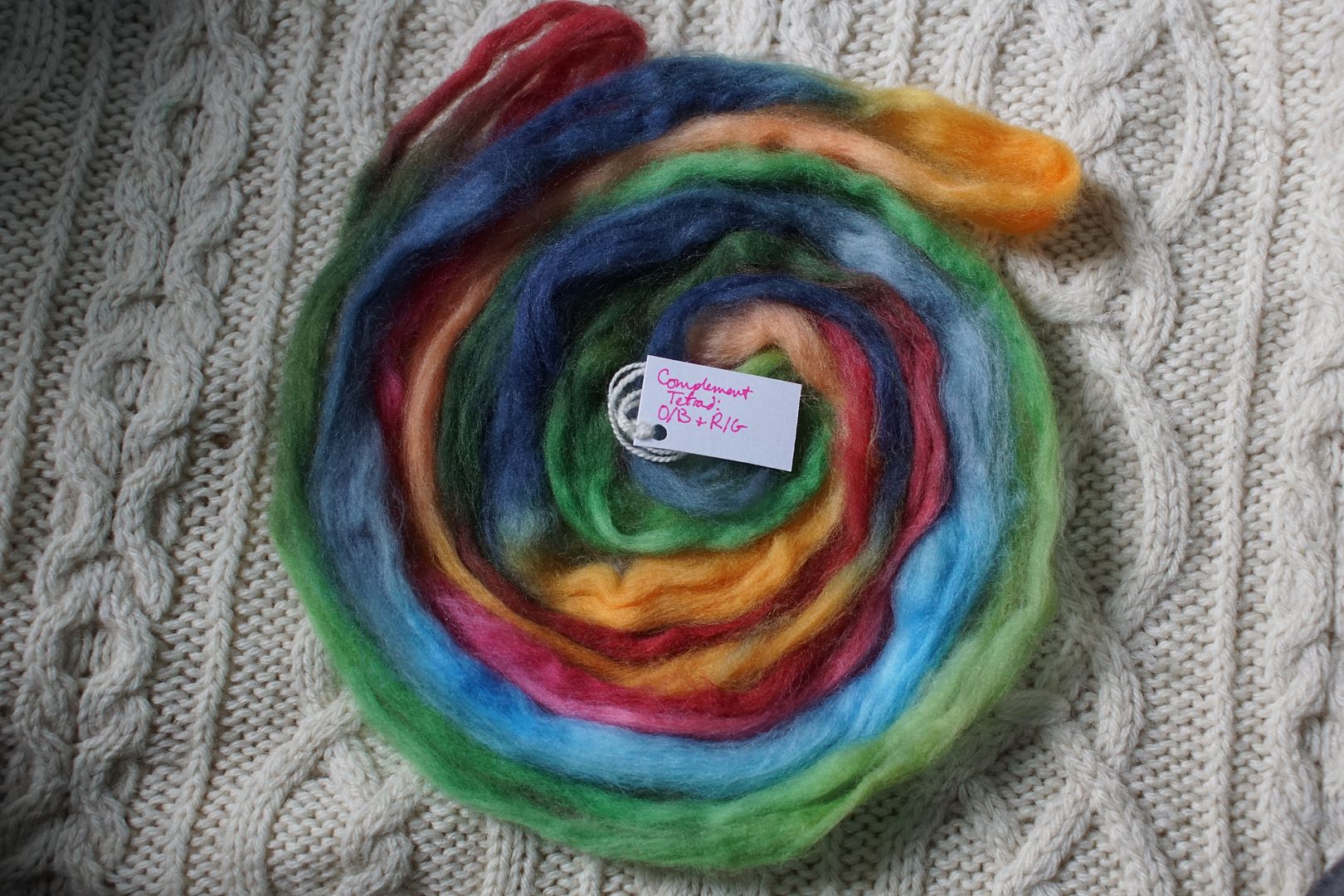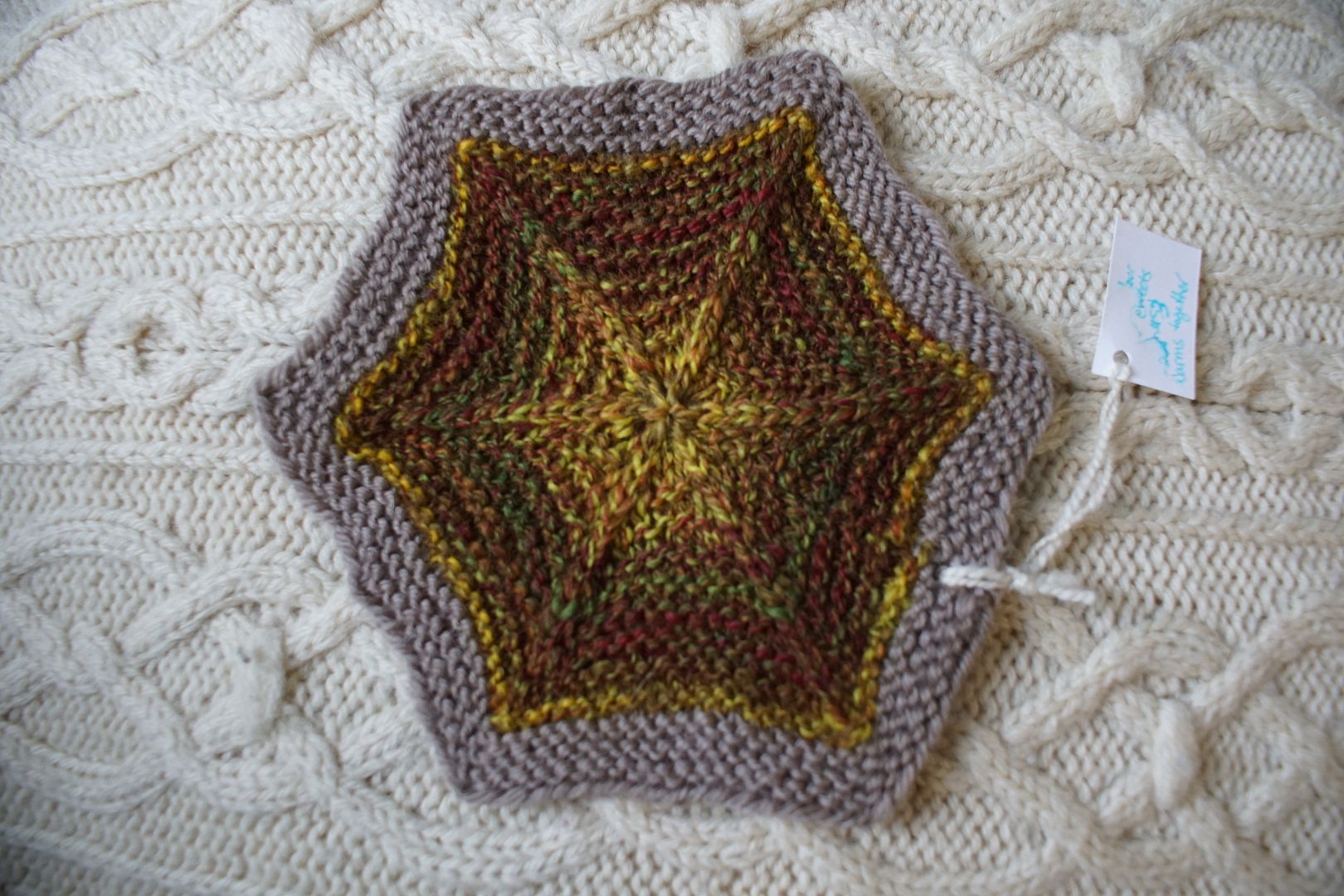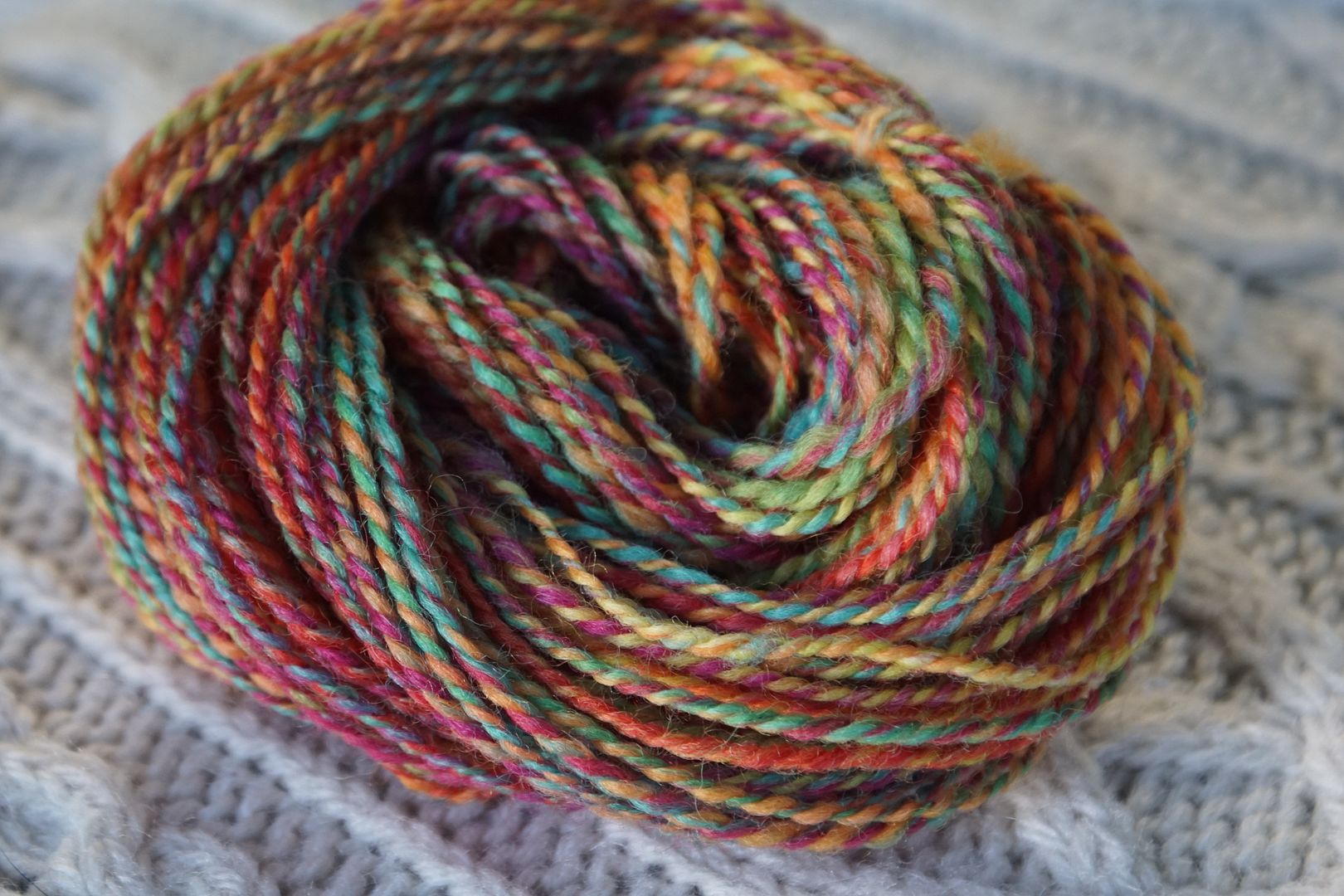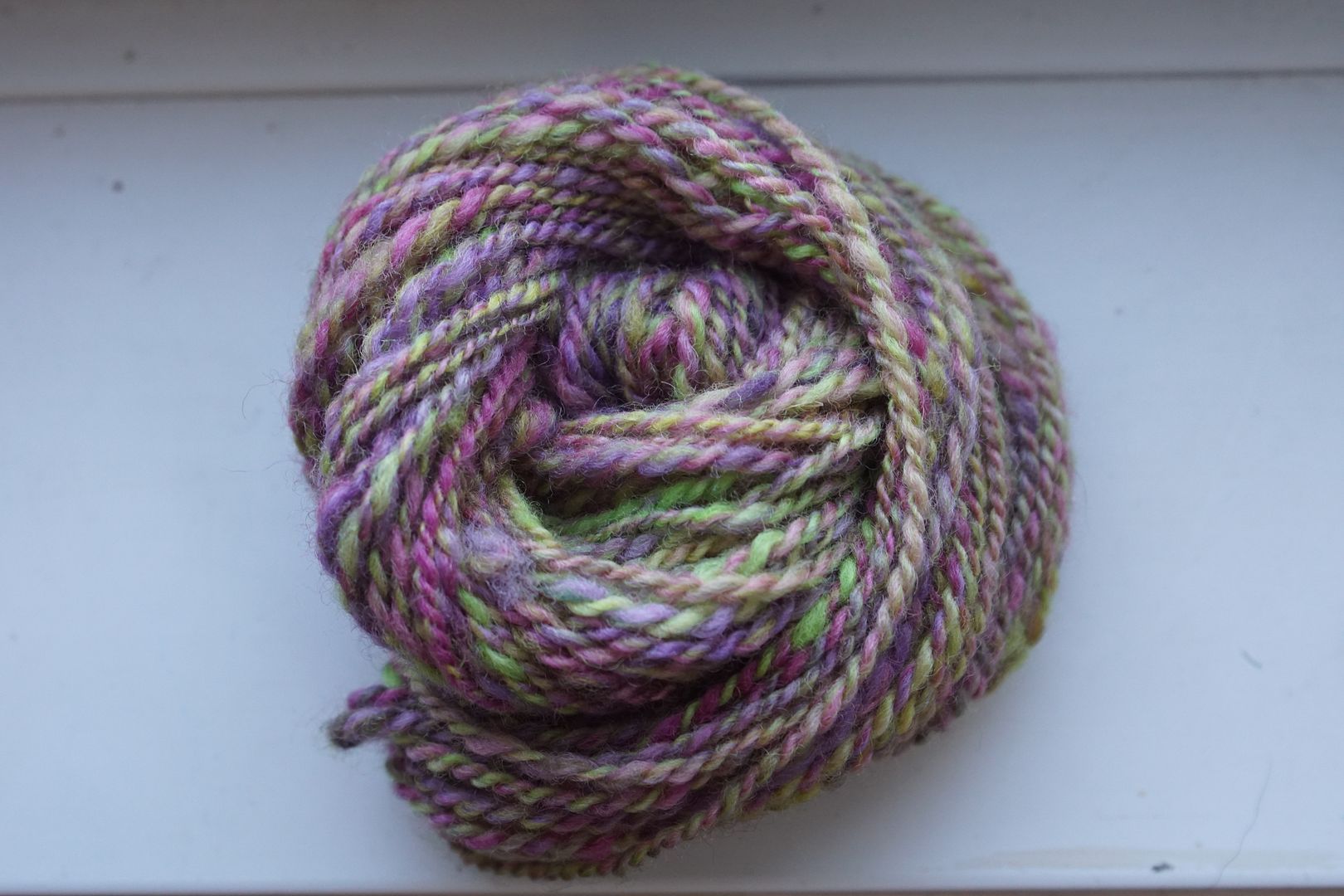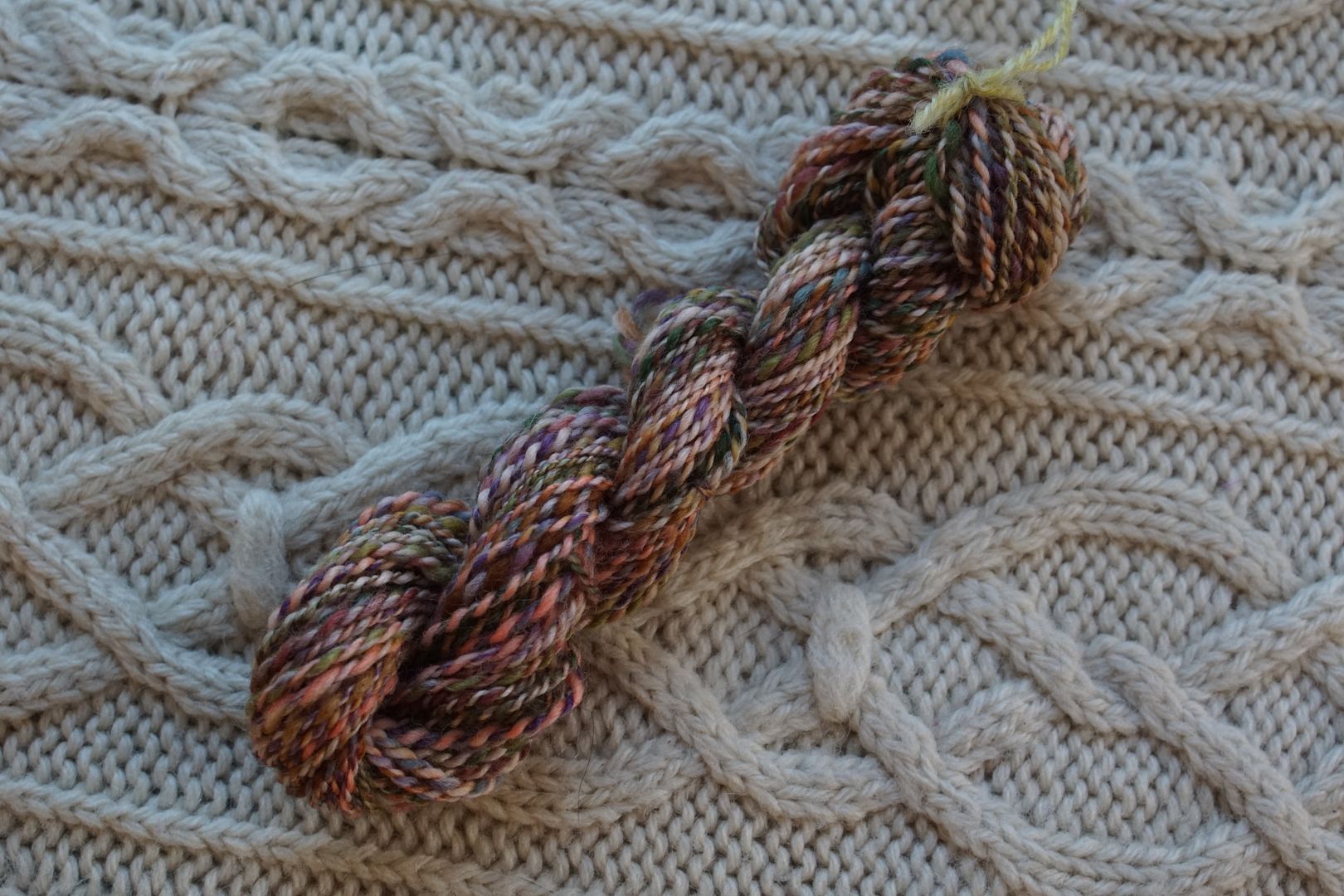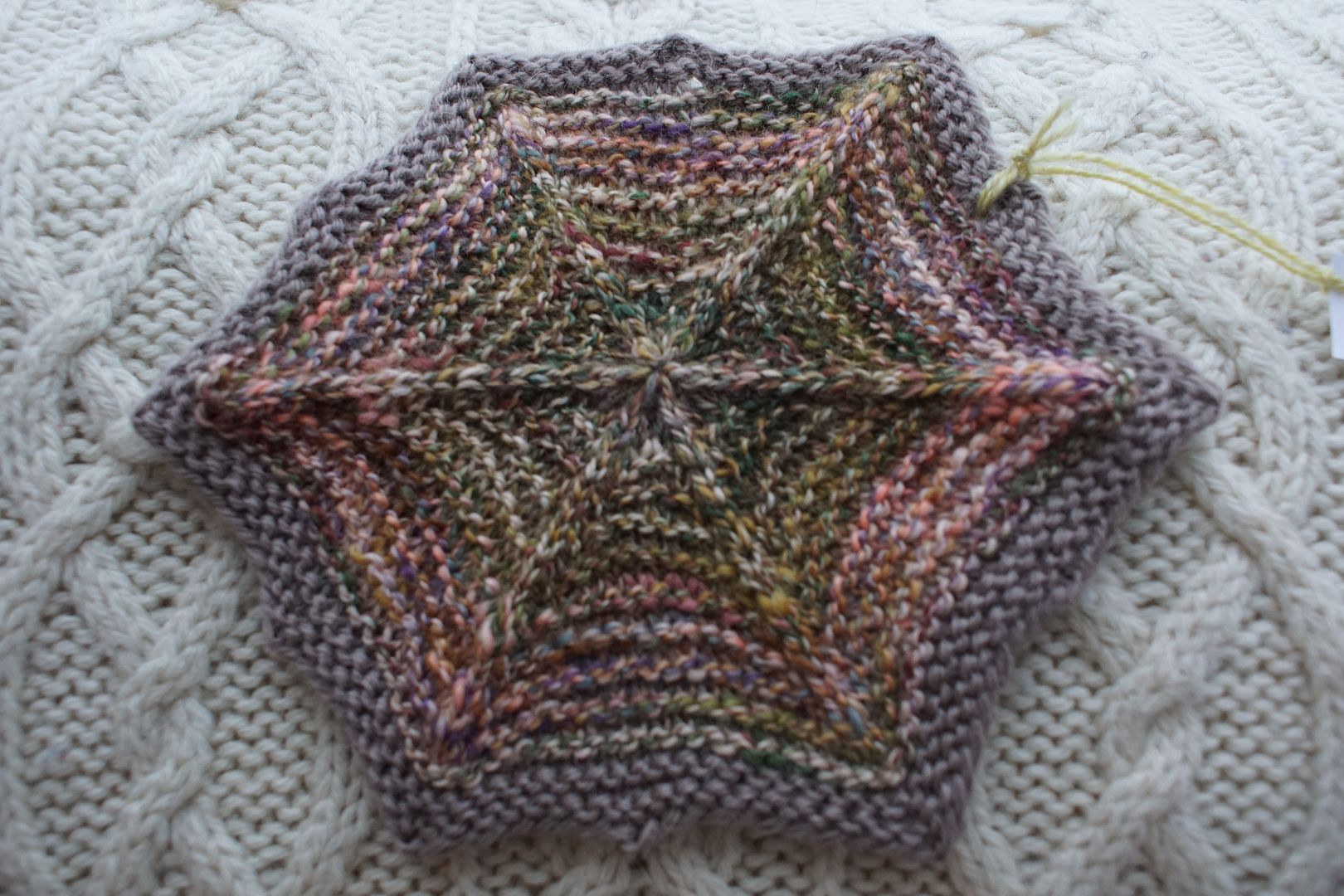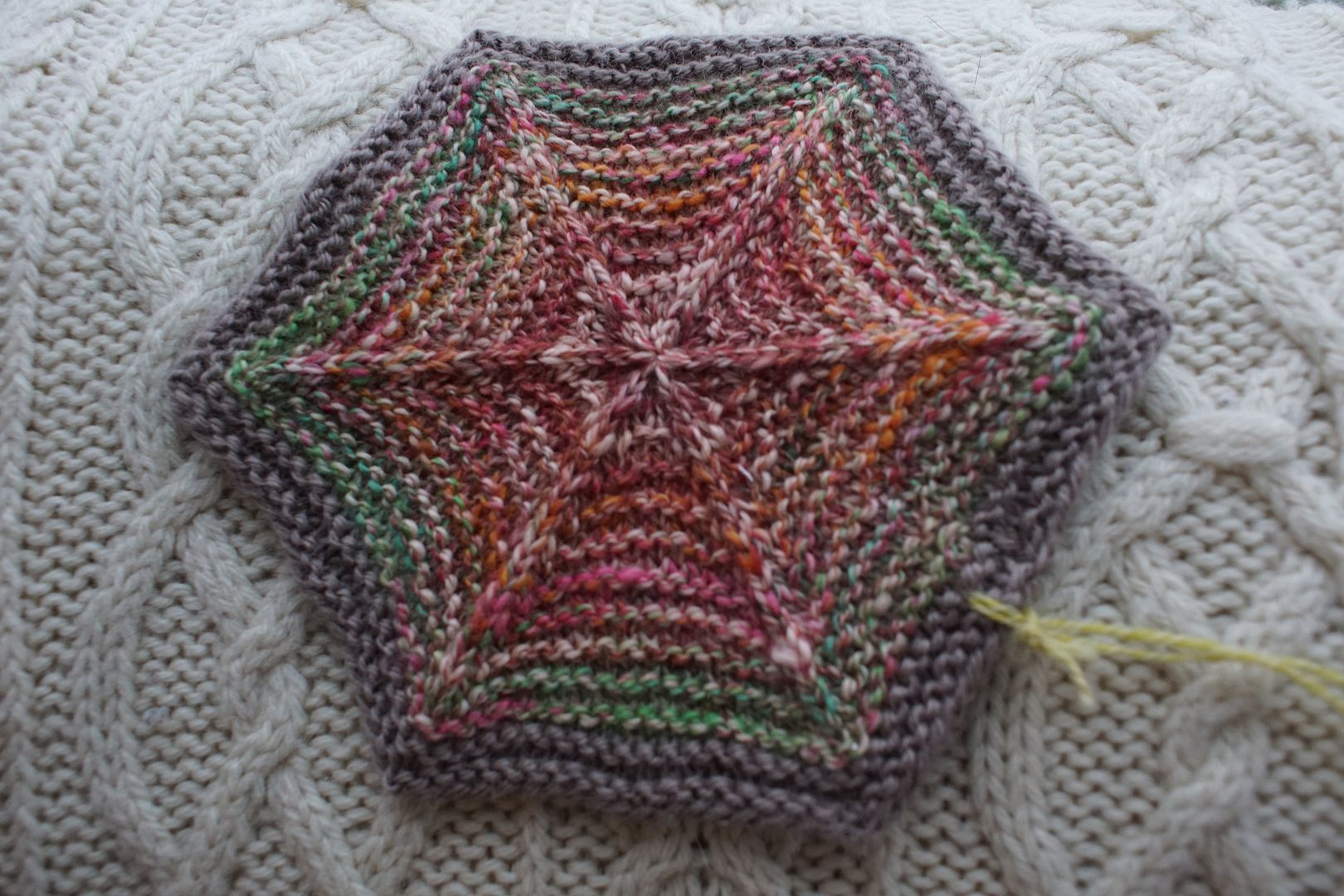Let’s crack on, shall we?
In the first corner, these are colours dominated by red. I’ve mapped them out below. The hexies in this area without numbers are from samples spun from a single handdyed colourway. You can find them in this post.
Below, I’ve ordered them by the most saturated, or most generally red-looking, to the least saturated. As you look through them, which ones stand out to you? Which combinations surprised you? Tell me which one is your favourite, but also tell me – why?
Exercise #: 3.c
Exercise name: Colour effects
Strip 1: 43 – Split Complement Blue-Green/Red,Orange
Strip 2: 44 – Split Complement Green/Red-Violet,Red-Orange
Prep method: Narrow strips held
Spinning tool: EEW6
Wool breed: Polwarth
Contrast of hue: High
Contrast of value: Low middle minor
Cold-Warm Contrast: Warms take over, cool is in pops
Complementary Contrast: Present
Simultaneous Contrast: Evident in the light teal shifting blue, perhaps paired with the pops of red-orange shifting orange.
Contrast of Saturation: Lots of desaturated red, saturated green and orange is in small amounts
Contrast of Proportion: terra cotta allies w orange to make high percentage and take over
There’s a colour name I bat around a lot in my head in this section of the blanket: terra cotta. For some reason that dull, dark red came through in a lot of my dyeing. It has this tendency to grab the surround colours and swallow them. It’s not a colour I love, and I’m quite suspicious of it! It forms the background of several of these hexies.
Exercise #: 5.c
Exercise name: Common Hue
Strip 1: 4 – Monochromatic Red-Orange
Strip 2: 14 – Analogous Dull Yellow-Orange to Red
Strip 3: 44 – Split Complement Green/Red-Violet,Red-Orange
Prep method: Narrow strips + predraft
Spinning tool: EEW6
Wool breed: Cor2+Pol1
Contrast of hue: High
Contrast of value: Low middle minor
Cold-Warm Contrast: Common hue terra cotta is warm, only real cools are green and violet
Complementary Contrast: Present
Simultaneous Contrast: Evident, green made to look cool and pop, but quite blended
Contrast of Saturation: Everything middling desaturated except red-orange
Contrast of Proportion: Reds and oranges unite and take over, well blended so others are complex and subtle
Exercise #: 8a.a
Exercise name: 3 Warms + 1 Cool
Strip 1: 15 – Analogous Intense Orange to Red-Violet
Strip 2: 51 – Cools:Intense
Strip 3: 52 – Warms:Yellows+Greens
Strip 4: 53 – Warms:Yellows+Reds
Prep method: Blending Board – stripped
Spinning tool: EEW6
Wool breed: Cor2+Pol2
Contrast of hue: High
Contrast of value: Middle minor-ish
Cold-Warm Contrast: Dominated by warms, but cool is very cool, and warms very different to each other
Complementary Contrast: Present
Simultaneous Contrast: Not evident – blue pops but does not shift, green does not pop
Contrast of Saturation: Warms more saturated overall but varied, cools less saturated
Contrast of Proportion: Are warms “stronger” than cools? Red slightly dominates, supported by browns, oranges, pinks; dull green disappears, blue pops
This one is so interesting because it looks like such a balanced mix to me. I accidentally spun it on the thicker side, but it still blended very well with how I prepped it on the blending board. It’s so deliciously complex and hard to pin down, and the flecks of blue throughout are like jewels, rather than seeming out of place.
Exercise name: 3 Warms + 1 Cool
Strip 1: 10 – Monochromatic Blue-Green
Strip 2: 14 – Analogous Dull Yellow-Orange to Red
Strip 3: 15 – Analogous Intense Orange to Red-Violet
Strip 4: 27 – Analogous Red to Orange
Prep method: Blending board – unstripped?
Spinning tool: EEW6
Wool breed: Cor3+Pol1
Contrast of hue: High
Contrast of value: Middle major-ish
Cold-Warm Contrast: Warms all very warm, cool very cool, not subtle
Complementary Contrast: Present (tertiary: B-G/R-O)
Simultaneous Contrast: Not sure – Doesn’t really shift, but turquoise does pop.
Contrast of Saturation: Dominant warms are 1/3 saturated, cools all saturated, makes for a good argument
Contrast of Proportion: Warmth dominates, but all stays more saturated than some
This was in the same batch as the previous thickly-spun, well-blended yarn. Again here, the complementary cool “pop” is a really just one hue, and I think simultaneous contrast makes it stand out even more. It reminds me of distant memories of Albuquerque – demonstrating how powerful associations are in our interpretation of colour.
Exercise #: 13c
Exercise name: Random
Strip 1: 13 – Analogous Pale Yellow to Red-Orange
Strip 2: 33 – Complement Red-Violet/Yellow-Green
Strip 3: 42 – Split Complement Blue/Yellow-Orange,Red-Orange
Strip 4: 46 – Triad:Primaries
Prep method: Stripped and held together
Spinning tool: EEW6
Wool breed: Cor1+Pol3
Contrast of hue: High
Contrast of value:
Cold-Warm Contrast: More warms, just a bit of blues and greens and cooler reds
Complementary Contrast: Present
Simultaneous Contrast: Not obviously evident to me, except perhaps in flecks of blue-green
Contrast of Saturation: Mix of everything, pale, dull, intense, dark
Contrast of Proportion: Surprisingly the pale oranges and the dull and dark reds blended to a varied terra-cotta background, with all the cools adding beautiful complexity.
For some reason, I thought this colourway would come out much brighter than it did. that terra cotta is there again, consuming everything in its path. This time it doesn’t bother me as much, though. The pops of other colours are spread throughout, and the grey-blue in particular seems to ground it.
Exercise #: 2b.c
Exercise name: High Hue Contrast
Strip 1: 37 – Split Complement Red-Orange/Blue,Green
Strip 2: 43 – Split Complement Blue-Green/Red,Orange
Prep method: Hand Cards-Puni
Spinning tool: Blondie
Wool breed: Polwarth
Contrast of hue: Extreme
Contrast of value: Middle minor (well-blended)
Cold-Warm Contrast: Lots of cool blues, quarter oranges, cool reds
Complementary Contrast: Present
Simultaneous Contrast: Evident in pops of teal and pink shifted red
Contrast of Saturation: Oranges very saturated, everything else less so
Contrast of Proportion: Cools took over, well-blended making plenty of mud
Making mud is hard to do, as we learned this year. But here I kinda managed it, by the way I blended the colours, and by virtue of the values being similar. If you want to blend colours into mud, having the values close together is a great way to do it, though it doesn’t always work of course (see yesterday’s post and 4b, which stayed speckly and bright).
Exercise #: 2b.a
Exercise name: High Hue Contrast
Strip 1: 30 – Complement Orange/Blue
Strip 2: 32 – Complement Red/Green
Prep method: Drum Carder-Lifted
Spinning tool: Blondie
Wool breed: Polwarth
Contrast of hue: Extreme
Contrast of value: Middle Major
Cold-Warm Contrast: Extreme, mixed, irrelevant
Complementary Contrast: Present
Simultaneous Contrast: Not evident; complements muddied
Contrast of Saturation: Fairly even in fiber
Contrast of Proportion: Very even. Extreme Hue contrast + low value contrast = mud
Same concept, but here similar colours lined up in plying, which prevented too much mud and mixing from happening. This was something that could have been prevented in prep, but it was one of my first ones!
Exercise #: 3.a
Exercise name: Colour effects
Strip 1: 52 – Warms:Yellows+Greens
Strip 2: 53 – Warms:Yellows+Reds
Prep method: Predrafted together
Spinning tool: EEW6
Wool breed: Corriedale
Contrast of hue: High
Contrast of value: Low major
Cold-Warm Contrast: Warms and warm undertones
Complementary Contrast: Present
Simultaneous Contrast: Evident (red and green)
Contrast of Saturation: All quite saturated except brown
Contrast of Proportion: Maybe ¼ yellow very loud, 1/3 brown takes a muddy back seat
These are the two “warm” colourways I dyed at the very end of my Dyeapalooza, and I really wanted to see them together. Unfortunately the yellows came together in both spinning and plying, as did the darker values, so there’s a good bit of striping. Still, warm earthy colours are my happy place!
Exercise #: 9a.a
Exercise name: Complementary
Strip 1: 15 – Analogous Intense Orange to Red-Violet
Strip 2: 22 – Analogous Dull Blue-Green to Yellow
Prep method: Dizzed through hand card
Spinning tool: EEW6
Wool breed: Corriedale
Contrast of hue: High
Contrast of value: Middle major
Cold-Warm Contrast: More warms than cools, warmer 2/3 of the colour wheel
Complementary Contrast: Present (R/G, RO/BG, RV/YG)
Simultaneous Contrast: Not evident. Not really seeing shifting the way things lined up.
Contrast of Saturation: Red colourway intense, Green colourway dull but not too dull
Contrast of Proportion: Hard to say because singles lined up, but warms seem to have dominated; makes sense from intensity perspective
We’re getting to the hexies that just happen to be in this section because it’s where they went best, not because they’re really red. The yarn is gorgeous, and you can’t tell in the yarn how much it would stripe!
Exercise #: 2b.b
Exercise name: High Hue Contrast
Strip 1: 28 – Complement Yellow/Violet
Strip 2: 33 – Complement Red-Violet/Yellow-Green
Prep method: Drum Carder-Dizzed
Spinning tool: Blondie
Wool breed: Polwarth
Contrast of hue: High
Contrast of value: High middle major
Cold-Warm Contrast: Slightly more cool purples than warm yellows and greens
Complementary Contrast: Present
Simultaneous Contrast: Kinda evident, some mud and some pop
Contrast of Saturation: Fairly even all over, contributing to mud
Contrast of Proportion: More purple than yellows/greens, overall feels more purple
This is a good example of complements desaturating each other. Sometimes they look more speckled, but since the individual colours were already on the paler side, there was more optical mixing. Out of all the combo drafts, this is the one that mixed most closely to the background “Latte” colour.
Exercise #: 10b.a
Exercise name: Add light value
Strip 1: 42 – Split Complement Blue/Yellow-Orange,Red-Orange
Strip 2: 47 – Triad:Secondaries
Strip 3: peach
Prep method: Dizzed through hand card
Spinning tool: EEW6
Wool breed: Pol2+Merino1
Contrast of hue: Moderate
Contrast of value: High major
Cold-Warm Contrast: Mix of warms and cools, but everything has a cool undertone
Complementary Contrast: Present but muted
Simultaneous Contrast: Possibly evident with how the pale peach and dark green interact
Contrast of Saturation: Darks, pales, and dulls throughout, evenly desaturated
Contrast of Proportion: Pale peach dominates, supported by tans, purples, and reds which recede; green surprisingly aggressive for small amount
This is in my top ten favourite hexies, and I couldn’t even tell you why. It’s got a surprise and a pizzazz to it, despite being so desaturated and earthy. Is it that concept of simultaneous contrast that sets the peach and green off from each other so nicely? Dear me, I love this.
Exercise #: 10b.b
Exercise name: Add light value
Strip 1: 43 – Split Complement Blue-Green/Red,Orange
Strip 2: 32 – Complement Red/Green
Strip 3: peach
Prep method: Dizzed through hand card
Spinning tool: EEW6
Wool breed: Pol2+Merino1
Contrast of hue: High
Contrast of value: High middle major
Cold-Warm Contrast: Mostly warm, though cool undertone present almost everywhere
Complementary Contrast: Present
Simultaneous Contrast: Colours lined up so it’s hard to say, possibly in the way the little bit of pink pops and blue-green shifts more green
Contrast of Saturation: Handpaints quite saturated, compared to pale solid. Would have been quite different had the reds and greens mixed more.
Contrast of Proportion: Saturated colours 2/3 proportion, they are desaturated by the pale peach throughout. Again would have been quite different had the reds and greens mixed more.
These complements intensify each other rather than desaturating, despite the peach making everything lighter.
I think a theme running through this red corner is that I like almost anything when it’s more blended, and I dislike almost everything when it stripes. But then, when you zoom out and see all the hexies together, the sheer variety and movement makes everything seem wonderful, but who knows?
